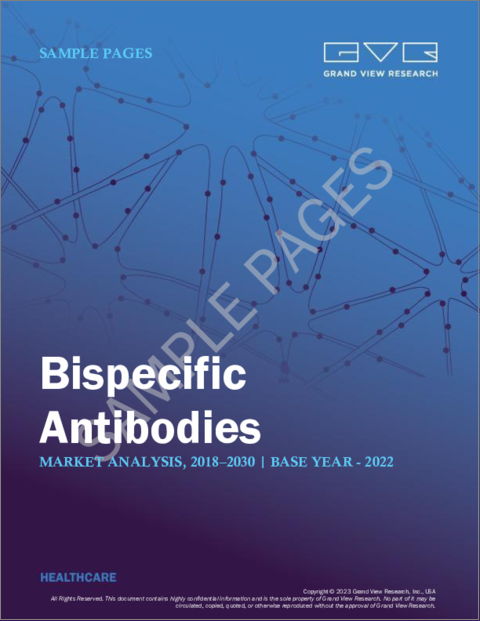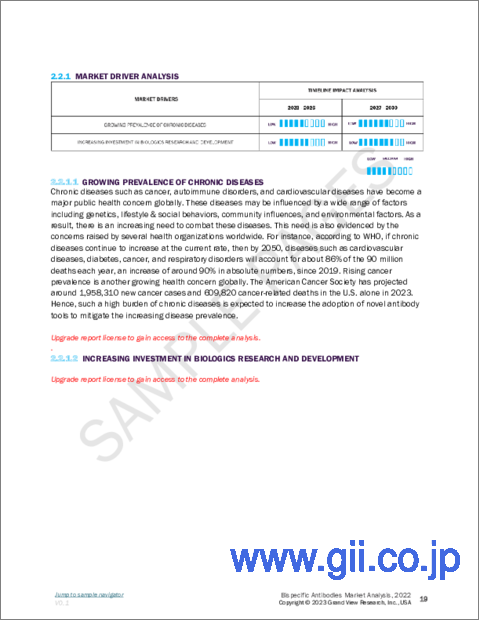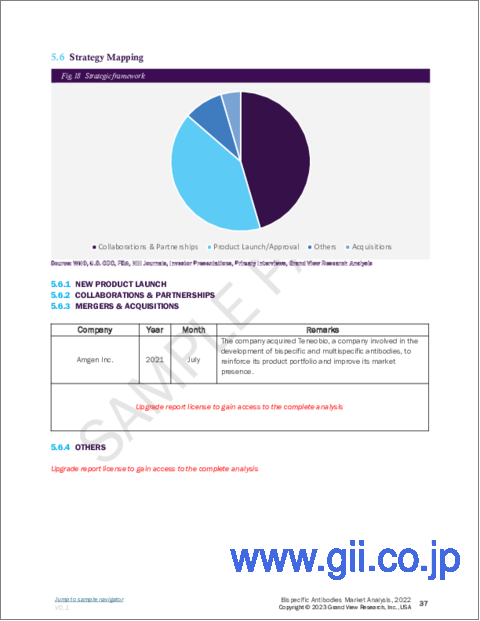|
|
市場調査レポート
商品コード
1301042
二重特異性抗体の市場規模、シェア、動向分析レポート:適応症別、地域別、セグメント予測、2023年~2030年Bispecific Antibodies Market Size, Share & Trends Analysis Report By Indication (Cancer, Inflammatory & Autoimmune disorders), By Region (North America, Europe, Asia Pacific), And Segment Forecasts, 2023 - 2030 |
||||||
|
● お客様のご希望に応じて、既存データの加工や未掲載情報(例:国別セグメント)の追加などの対応が可能です。 詳細はお問い合わせください。 |
|||||||
| 二重特異性抗体の市場規模、シェア、動向分析レポート:適応症別、地域別、セグメント予測、2023年~2030年 |
|
出版日: 2023年06月15日
発行: Grand View Research
ページ情報: 英文 120 Pages
納期: 2~10営業日
|
- 全表示
- 概要
- 図表
- 目次
二重特異性抗体市場の成長と動向
GrandView Research, Inc.の最新レポートによると、二重特異性抗体の世界市場規模は、2023年から2030年にかけて44.0%のCAGRで拡大し、2030年には1,103億米ドルに達すると予測されています。
乳がん、肺がん、前立腺がん、その他の慢性疾患などのがんの有病率の増加が市場成長の主な促進要因です。これらの分子は、がん細胞と免疫系を同時に標的とすることで、特定のタイプのがんを治療する標的アプローチを提供します。さらに、個別化医療に対する需要の高まりと標的療法へのシフトが市場の成長に寄与しています。
さらに、製薬会社とバイオテクノロジー企業との共同研究や提携は、二重特異性抗体の研究開発を進める上で重要な役割を果たしています。こうした共同研究は、新規二特異性抗体の発見と臨床開拓を加速させ、市場の成長をさらに後押ししています。例えば、2022年1月、アムジェンとジェネレート・バイオメディシンズは、異なる治療領域や様式にまたがる5つの臨床標的に対するタンパク質治療法を発見・開発するための研究提携契約を締結しました。さらに2023年5月、米国FDAはEPKINLY(epcoritamab-bysp)を再発または難治性のびまん性大細胞型B細胞リンパ腫(DLBCL)の治療薬として承認しました。
COVID-19の大流行は、二重特異性抗体業界に二重の影響を与えました。一方では、感染症対策における二特異性抗体の重要性を強調しました。しかし、パンデミックはサプライチェーンの混乱という形で課題ももたらし、二重特異性抗体の研究開発の遅れにつながっています。さらに、経済の不確実性や予算の制約が研究機関やバイオテクノロジー企業に影響を及ぼし、二特異性抗体開発の優先順位や資源配分に影響を与える可能性があります。
さらに、新興国参入企業による様々な開拓や産学連携の増加が、世界市場を大きく牽引しています。例えば、2023年3月、サーモフィッシャーサイエンティフィック社は、自己T細胞療法の臨床製造を促進・支援するため、細胞療法企業のアーセナル・バイオサイエンス社と提携しました。
二重特異性抗体市場レポートハイライト
- 適応症別では、世界的にがんの有病率が高いことから、2022年にはがん分野が70.4%のシェアを占め、市場を独占しました。さらに、二特異性抗体は腫瘍細胞や腫瘍関連抗原を特異的に標的とする一方、健常細胞は温存します。
- 炎症性疾患および自己免疫疾患分野は、関節リウマチ、乾癬、クローン病、多発性硬化症などの治療に二特異性抗体医薬品の採用と開発が増加していることから、2023年から2030年にかけて35.7%の大幅なCAGRで成長すると予想されます。
- 北米は、高度に発達したヘルスケア・インフラと有利な政府政策により、2022年には89.5%のシェアを獲得し、世界市場で確固たる地位を築いた。
目次
第1章 調査手法と範囲
- 情報調達
- 情報またはデータ分析
- 市場範囲とセグメントの定義
- 市場モデル
- 企業市場シェア別の市場調査
- 地域分析
第2章 エグゼクティブサマリー
- 市場スナップショット
- セグメントのスナップショット
- 競合情勢のスナップショット
第3章 市場変数、動向、および範囲
- 市場系統の見通し
- 親市場の見通し
- 関連/補助的な市場見通し
- 市場力学
- 市場促進要因分析
- 市場抑制要因分析
- 業界分析ツール
- ポーターのファイブフォース分析
- PESTEL分析
- COVID-19感染症の影響分析
- パイプライン分析
第4章 指標ビジネス分析
- 二重特異性抗体市場:適応症の変動分析
- がん
- 炎症性疾患および自己免疫疾患
- その他
第5章 地域ビジネス分析
- 地域別二重特異性抗体市場シェア、2022年および2030年
- 北米
- 北米二重特異性抗体市場、2018年~2030年
- 米国
- カナダ
- 欧州
- 欧州二重特異性抗体市場、2018年~2030年
- 英国
- ドイツ
- アジア太平洋地域
- アジア太平洋地域の二重特異性抗体市場、2018年~2030年
- 日本
- 中国
- 世界のその他の地域
- 世界のその他の地域の二重特異性抗体市場、2018-2030
第6章 競合情勢
- 企業の分類
- 戦略マッピング
- 企業の市場シェア分析、2022年
- 企業プロファイル・一覧表
- Amgen
- Roche
- Genentech
- Akeso, Inc
- Janssen
- Taisho Pharmaceutical
- Immunocore
List of Tables
- TABLE 1. List of abbreviations
- TABLE 2. Global bispecific antibodies market, by indication, 2018 - 2030 (USD Million)
- TABLE 3. North America bispecific antibodies market, by country, 2018 - 2030 (USD Million)
- TABLE 4. North America bispecific antibodies market, by indication, 2018 - 2030 (USD Million)
- TABLE 5. U.S. bispecific antibodies market, by indication, 2018 - 2030 (USD Million)
- TABLE 6. Canada bispecific antibodies market, by indication, 2018 - 2030 (USD Million)
- TABLE 7. Europe bispecific antibodies market, by country, 2018 - 2030 (USD Million)
- TABLE 8. Europe bispecific antibodies market, by indication, 2018 - 2030 (USD Million)
- TABLE 9. UK bispecific antibodies market, by indication, 2018 - 2030 (USD Million)
- TABLE 10. Germany bispecific antibodies market, by indication, 2018 - 2030 (USD Million)
- TABLE 11. Asia Pacific bispecific antibodies market, by country, 2018 - 2030 (USD Million)
- TABLE 12. Japan bispecific antibodies market, by indication, 2018 - 2030 (USD Million)
- TABLE 13. China bispecific antibodies market, by indication, 2018 - 2030 (USD Million)
- TABLE 14. Rest of World bispecific antibodies market, by country, 2018 - 2030 (USD Million)
List of Figures
- FIG. 1 Market research process
- FIG. 2 Information procurement
- FIG. 3 Primary research pattern
- FIG. 4 Market research approaches
- FIG. 5 Value chain-based sizing & forecasting
- FIG. 6 Market formulation & validation
- FIG. 7 Bispecific Antibodies market segmentation
- FIG. 8 Market snapshot, 2022
- FIG. 9 Market trends & outlook
- FIG. 10 Market driver relevance analysis (current & future impact)
- FIG. 11 Market restraint relevance analysis (current & future impact)
- FIG. 12 PESTEL analysis
- FIG. 13 Porter's five forces analysis
- FIG. 14 Global bispecific antibodies market: Indication movement analysis
- FIG. 15 Global bispecific antibodies market, for cancer, 2018 - 2030 (USD Million)
- FIG. 16 Global bispecific antibodies market, for Inflammatory & Autoimmune Disorders, 2018 - 2030 (USD Million)
- FIG. 17 Global bispecific antibodies market, for others 2018-2030, (USD Million)
- FIG. 18 Global bispecific antibodies market: Region movement analysis
- FIG. 19 North America bispecific antibodies market, 2018 - 2030 (USD Million)
- FIG. 20 U.S. bispecific antibodies market, 2018 - 2030 (USD Million)
- FIG. 21 Canada bispecific antibodies market, 2018 - 2030 (USD Million)
- FIG. 22 Europe bispecific antibodies market, 2018 - 2030 (USD Million)
- FIG. 23 Germany bispecific antibodies market, 2018 - 2030 (USD Million)
- FIG. 24 UK bispecific antibodies market, 2018 - 2030 (USD Million)
- FIG. 25 Asia Pacific bispecific antibodies market, 2018 - 2030 (USD Million)
- FIG. 26 Japan bispecific antibodies market, 2018 - 2030 (USD Million)
- FIG. 27 China bispecific antibodies market, 2018 - 2030 (USD Million)
- FIG. 28 Rest of the World bispecific antibodies market, 2018 - 2030 (USD Million)
Bispecific Antibodies Market Growth & Trends
The global bispecific antibodies market size is expected to reach USD 110.3 billion by 2030, expanding at a CAGR of 44.0% from 2023 to 2030, according to a new report by Grand View Research, Inc. The increasing prevalence of cancers such as breast cancer, lung cancer, prostate cancer, and other chronic diseases is a major driver for market growth. These molecules provide a targeted approach to treat specific types of cancer by simultaneously targeting cancer cells and the immune system. Additionally, the rising demand for personalized medicine and the shift toward targeted therapies have contributed to the market's growth.
Moreover, collaborations and partnerships between pharmaceutical companies and biotechnology firms have played a crucial role in advancing bispecific antibody research and development. These collaborations have accelerated the discovery and clinical development of novel bispecific antibodies, further propelling the market growth. For instance, in January 2022, Amgen and Generate Biomedicines established a research partnership agreement to discover and develop protein therapies for five clinical targets spanning different therapeutic areas and modalities. In addition to it, in May 2023, The U.S. FDA approved EPKINLY (epcoritamab-bysp) as the inaugural bispecific antibody to be authorized for the treatment of relapsed or refractory Diffuse Large B-Cell Lymphoma (DLBCL) in adult patients.
The COVID-19 pandemic has had a dual impact on the bispecific antibodies industry. On one hand, it has underscored the significance of bispecific antibodies in addressing infectious diseases. However, the pandemic has also introduced challenges in the form of supply chain disruptions, leading to delays in the research and development of bispecific antibodies. Furthermore, economic uncertainties and budget constraints have affected research institutions and biotech companies, potentially influencing their prioritization and allocation of resources towards bispecific antibody development.
Furthermore, various developments undertaken by participants, and increasing industry-academia collaborations have driven the global market to a significant extent. For instance, in March 2023, Thermo Fisher Scientific Inc collaborated with Arsenal Bioscience, a cell therapy company to facilitate and support the clinical manufacturing of Autologous T-Cell Therapies.
Bispecific Antibodies Market Report Highlights
- By indication, the cancer segment dominated the market with a share of 70.4% in 2022, due high prevalence of cancer globally. Furthermore, bispecific antibodies specifically target tumor cells or tumor-associated antigens while sparing healthy cells
- Inflammatory and autoimmune disorders segment is expected to grow at a significant CAGR of 35.7% during 2023-2030, owing to the increasing adoption and development of bispecific antibody drugs for the treatment of rheumatoid arthritis, psoriasis, Crohn's disease, and multiple sclerosis among others.
- North America established a strong regional position in the global market with an 89.5% share in 2022 due to its highly developed healthcare infrastructure and favorable government policies
Table of Contents
Chapter 1. Methodology and Scope
- 1.1. Information Procurement
- 1.2. Information Or Data Analysis
- 1.3. Market Scope & Segment Definition
- 1.4. Market Model
- 1.4.1. Market Study, By Company Market Share
- 1.4.2. Regional Analysis
Chapter 2. Executive Summary
- 2.1. Market Snapshot
- 2.2. Segment Snapshot
- 2.3. Competitive Landscape Snapshot
Chapter 3. Market Variables, Trends, & Scope
- 3.1. Market Lineage Outlook
- 3.1.1. Parent Market Outlook
- 3.1.2. Related/Ancillary Market Outlook
- 3.2. Market Dynamics
- 3.2.1. Market Driver Analysis
- 3.2.1.1. Growing prevalence of chronic diseases
- 3.2.1.2. Increasing investment in biologics research and development
- 3.2.2. Market Restraint Analysis
- 3.2.2.1. High development cost
- 3.2.1. Market Driver Analysis
- 3.3. Industry Analysis Tools
- 3.3.1. Porter's Five Forces Analysis
- 3.3.2. PESTEL Analysis
- 3.3.3. COVID-19 Impact Analysis
- 3.4. Pipeline Analysis
Chapter 4. Indication Business Analysis
- 4.1. Bispecific Antibodies Market: Indication Movement Analysis
- 4.2. Cancer
- 4.2.1. Cancer Market, 2018 - 2030 (USD Million)
- 4.3. Inflammatory & Autoimmune Disorders
- 4.3.1. Inflammatory & Autoimmune Disorders Market, 2018 - 2030 (USD Million)
- 4.4. Others
- 4.4.1. Others Market, 2018 - 2030 (USD Million)
Chapter 5. Regional Business Analysis
- 5.1. Bispecific Antibodies Market Share By Region, 2022 & 2030
- 5.2. North America
- 5.2.1. North America Bispecific Antibodies Market, 2018 - 2030 (USD Million)
- 5.2.2. The U.S.
- 5.2.2.1. Key Country Dynamics
- 5.2.2.2. Target Disease Prevalence
- 5.2.2.3. Competitive Scenario
- 5.2.2.4. Regulatory Framework
- 5.2.2.5. U.S. Bispecific Antibodies Market, 2018 - 2030 (USD Million)
- 5.2.3. Canada
- 5.2.3.1. Key Country Dynamics
- 5.2.3.2. Target Disease Prevalence
- 5.2.3.3. Competitive Scenario
- 5.2.3.4. Regulatory Framework
- 5.2.3.5. Canada Bispecific Antibodies Market, 2018 - 2030 (USD Million)
- 5.3. Europe
- 5.3.1. Europe Bispecific Antibodies Market, 2018 - 2030 (USD Million)
- 5.3.2. UK
- 5.3.2.1. Key Country Dynamics
- 5.3.2.2. Target Disease Prevalence
- 5.3.2.3. Competitive Scenario
- 5.3.2.4. Regulatory Framework
- 5.3.2.5. UK Bispecific Antibodies Market, 2018 - 2030 (USD Million)
- 5.3.3. Germany
- 5.3.3.1. Key Country Dynamics
- 5.3.3.2. Target Disease Prevalence
- 5.3.3.3. Competitive Scenario
- 5.3.3.4. Regulatory Framework
- 5.3.3.5. Germany Bispecific Antibodies Market, 2018 - 2030 (USD Million)
- 5.4. Asia Pacific
- 5.4.1. Asia Pacific Bispecific Antibodies Market, 2018 - 2030 (USD Million)
- 5.4.2. Japan
- 5.4.2.1. Key Country Dynamics
- 5.4.2.2. Target Disease Prevalence
- 5.4.2.3. Competitive Scenario
- 5.4.2.4. Regulatory Framework
- 5.4.2.5. Japan Bispecific Antibodies Market, 2018 - 2030 (USD Million)
- 5.4.3. China
- 5.4.3.1. Key Country Dynamics
- 5.4.3.2. Target Disease Prevalence
- 5.4.3.3. Competitive Scenario
- 5.4.3.4. Regulatory Framework
- 5.4.3.5. China Bispecific Antibodies Market, 2018 - 2030 (USD Million)
- 5.5. Rest of the world
- 5.5.1. Rest of the world Bispecific Antibodies Market, 2018 - 2030 (USD Million)
Chapter 6. Competitive Landscape
- 6.1. Company Categorization
- 6.2. Strategy Mapping
- 6.3. Company Market Share Analysis, 2022
- 6.4. Company Profiles/Listing
- 6.4.1. Amgen
- 6.4.1.1. Overview
- 6.4.1.2. Financial Performance (Net Revenue/Sales/EBITDA/Gross Profit)
- 6.4.1.3. Product Benchmarking
- 6.4.1.4. Strategic Initiatives
- 6.4.2. Roche
- 6.4.2.1. Overview
- 6.4.2.2. Financial Performance (Net Revenue/Sales/EBITDA/Gross Profit)
- 6.4.2.3. Product Benchmarking
- 6.4.2.4. Strategic Initiatives
- 6.4.3. Genentech
- 6.4.3.1. Overview
- 6.4.3.2. Financial Performance (Net Revenue/Sales/EBITDA/Gross Profit)
- 6.4.3.3. Product Benchmarking
- 6.4.3.4. Strategic Initiatives
- 6.4.4. Akeso, Inc
- 6.4.4.1. Overview
- 6.4.4.2. Financial Performance (Net Revenue/Sales/EBITDA/Gross Profit)
- 6.4.4.3. Product Benchmarking
- 6.4.4.4. Strategic Initiatives
- 6.4.5. Janssen
- 6.4.5.1. Overview
- 6.4.5.2. Financial Performance (Net Revenue/Sales/EBITDA/Gross Profit)
- 6.4.5.3. Product Benchmarking
- 6.4.5.4. Strategic Initiatives
- 6.4.6. Taisho Pharmaceutical
- 6.4.6.1. Overview
- 6.4.6.2. Financial Performance (Net Revenue/Sales/EBITDA/Gross Profit)
- 6.4.6.3. Product Benchmarking
- 6.4.6.4. Strategic Initiatives
- 6.4.7. Immunocore
- 6.4.7.1. Overview
- 6.4.7.2. Financial Performance (Net Revenue/Sales/EBITDA/Gross Profit)
- 6.4.7.3. Product Benchmarking
- 6.4.7.4. Strategic Initiatives
- 6.4.1. Amgen




